Two other potentially excellent wines of St.-Julien are made at Gruaud Larose and Talbot. For years, these two estates were owned by the Cordier family. They have now been sold, and that is reflected in somewhat different styles of wine emerging from the new proprietors. Gruaud Larose sits back off the river behind Beychevelle and Branaire Ducru. Until the recent change in proprietors, Gruaud Larose and stable-mate and immediate northern neighbor Talbot produced densely colored, rich, fruity wines. In most vintages, Gruaud was superior to Talbot, which has a tendency to be austere, but the quality of these two wines, while historically quite good, was brilliant between 1978 and 1990. Furthermore, because they both produce in excess of 35,000 cases of wine, fetching a price per bottle that always appeared modest, Gruaud Larose and Talbot immensely satisfied both the purse and the palate. In particular, Gruaud Larose often performed at a first-growth quality level between 1961 and 1990. Although critics of Gruaud Larose suggest that it can lack the great complexity and staying power of a true first growth, such charges have proved baseless when the wine is compared in blind tastings against the first growths. Under the new owners, the wine appears to be made in a supple, more fruity and accessible style, without sacrificing its full-blooded, meaty, robust style. Talbot, still under partial Cordier ownership, looks also to be producing a more forward, fruitier, less tannic wine than the older pre-1990 offerings.
The remaining two St.-Julien classified growths, Lagrange and Saint-Pierre, both have undergone significant personality changes. Lagrange, lowly for decades, took on new owners from Japan, and with some expert start-up advice from the late Michel Delon of Léoville Las Cases, the improvements have been remarkable. This is now one of St.-Julien’s great wines—powerful, full-bodied, very concentrated, and obviously ageworthy. Moreover, its price is still reasonable, making it an insider’s choice from St.-Julien.
Saint-Pierre has always been a terribly underrated property. The style of wine produced is rich in color and extract, full-bodied, sometimes a bit rustic, but always satisfyingly fat, robust, and fruity. Now the property and the wine are under the watchful eye of the late Henri Martin’s son-in-law, Jean-Louis Triaud, who also manages St.-Julien’s most famous Cru Bourgeois, Gloria. The transition to a “Martinized” style of St.-Julien was readily apparent with their first vintage, the 1983, a richly fruity, almost sweet, easy to drink, supple wine that has huge popular appeal. Saint-Pierre, probably St.-Julien’s most lavishly oaked, exotic, and flamboyant wine, has also been on a qualitative hot streak and merits considerable interest.
St.-Julien is not without some meritorious Cru Bourgeois properties. In addition to the excellent Gloria, there are the very good Terrey-Gros-Cailloux and Hortevie; the stylish, elegant Lalande-Borie; the rather commercial, sometimes dull, sometimes good du Glana; and a bevy of good deuxième, or second wines, from the major châteaux. The best of these is the Clos du Marquis from Léoville Las Cases, a brilliant wine.
St.-Julien is a good commune for treasure hunting when Bordeaux has a poor or mediocre vintage. In fact, St.-Julien’s soil is similar to the light, gravel-based earth of Margaux, except that it is richer in clay. This affords the wines more body and viscosity. Since most of the major vineyards are close to the Gironde, they tend to have excellent, well-drained, deep beds of gravel soil. In 1992, 1987, 1984, and 1980, all rain-plagued years, St.-Julien produced more acceptable wines than elsewhere in Bordeaux.
In the excellent-to-great vintages, St.-Juliens are quintessential Médocs. The 2000, 1996, 1995, 1990, 1989, 1986, 1985, 1982, 1970, 1961, and 1959 are the truly great vintages for this appellation, followed by 2001, 1988, 1983, 1966, and 1962.
ST.-JULIEN
(An Insider’s View)
Overall Appellation Potential: Excellent to Superb (from top to bottom the most consistent appellation of Bordeaux)
The Most Potential for Aging: Ducru-Beaucaillou, Gruaud Larose, Lagrange, Léoville Barton, Léoville Las Cases, Léoville Poyferré
The Most Elegant: Branaire Ducru, Ducru-Beaucaillou, Léoville Las Cases
The Most Concentrated: Ducru-Beaucaillou, Gruaud Larose, Lagrange, Léoville Barton, Léoville Las Cases, Léoville Poyferré
The Best Value: Branaire Ducru, Gloria, Hortevie, Saint-Pierre, Talbot
The Most Exotic: Branaire Ducru, Saint-Pierre
The Most Difficult to Understand (when young): Ducru-Beaucaillou
The Most Underrated: Lagrange, Saint-Pierre, Talbot
The Easiest to Appreciate Young: Gloria, Talbot
Up-and-Coming Estates: Lagrange, Saint-Pierre
Greatest Recent Vintages: 2000, 1996, 1995, 1990, 1989, 1986, 1985, 1982, 1961
ST.-JULIEN—AN OVERVIEW
Location: In many ways the center point of the Médoc, laying to the north of Margaux, bordered on the south by the village of Cussac-Fort-Médoc and on the north by Pauillac; it is approximately 22 miles north of the city of Bordeaux.
Acres Under Vine: 2,175
Communes: St.-Julien is the major commune, along with small parcels of Cussac and St.-Laurent; some of the St.-Julien commune actually sits within Pauillac
Average Annual Production: 490,000 cases
Classified Growths: Total of 11: 5 second-growths, 2 third-growths, and 4 fourth-growths; there are 8 Crus Bourgeois
Principal Grape Varieties: Cabernet Sauvignon followed by Merlot and small quantities of Cabernet Franc. Varietal composition in St.-Julien tends to mirror Pauillac
Principal Soil Type: St.-Julien’s soil consists of extremely fine gravel, especially for the great vineyards adjacent to the river. Farther inland, there is considerable gravel but more clay
A CONSUMER’S CLASSIFICATION OF THE CHÂTEAUX OF ST.-JULIEN
OUTSTANDING
Ducru-Beaucaillou, Gruaud Larose, Léoville Barton, Léoville Las Cases, Léoville Poyferré
EXCELLENT
Branaire Ducru, Lagrange, Saint-Pierre, Talbot
VERY GOOD
Beychevelle, Gloria, Hortevie, Langoa Barton
GOOD
Lalande Borie, Terrey-Gros-Cailloux
OTHER NOTABLE ST.-JULIEN PROPERTIES
La Bridane, Domaine Castaing, du Glana, Lalande, Moulin de la Rose, Teynac
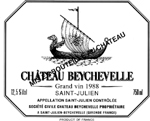
Classification: Fourth Growth in 1855
Owner: Grands Millésimes de France (GMF and Suntory)
Address: 33250 St.-Julien-Beychevelle
Telephone: 05 56 73 20 70; Telefax: 05 56 73 20 71
E-mail: beychevelle@beychevelle.com
Website: www.beychevelle.com
Visits: By appointment Monday to Friday, 10 A.M.–noon and 1:30–5 P.M.
VINEYARDS
Surface area: 222.3 acres
Grape varietals: 62% Cabernet Sauvignon, 31% Merlot, 5% Cabernet Franc, 2% Petit Verdot
Average age of vines: 28 years
Density of plantation: 8,300 and 10,000 vines per hectare
Average yields: 55 hectoliters per hectare
Elevage: Eight- to ten-day alcoholic fermentation, eighteen-day maceration in temperature-controlled stainless-steel and concrete vats at 28°C. Eighteen months aging in barrels with 57% new oak. Fining with egg whites. Regarding filtration, the estate decides on a per vintage basis.
Château Beychevelle: 265,000 bottles
Amiral de Beychevelle: 198,000 bottles
Plateau of maturity: Within 7–15 years of the vintage
GENERAL APPRECIATION
The wines of this estate have improved considerably since 1982. They are rarely profound yet are soundly made, charming, elegant, and finesse-styled. Some vintages lack that additional depth, structure, complexity, and substance that characterize the best St.-Juliens. Because of Beychevelle’s irregular performance, readers should be cautious. While it does not rank amongst the best St.-Julien, this wine is interesting because of its reasonable pricing. The superb 2000, 1989, 1986, and 1982 clearly demonstrate the estate’s potential. In the best years, Beychevelle can rival a third growth; in lesser ones, it does not surpass a fifth growth or even a top-quality Cru Bourgeois.
Tourists visiting Bordeaux are unlikely to miss Château Beychevelle because it is the first major château passed on the D2 road leading north into the commune of St.-Julien. The beautiful flowering gardens that face the road have caused many speeding drivers to stop and take photographs.
Although consistently inconsistent, the wines of Beychevelle can also be beautifully produced. During the decades of the 1960s and 1970s, quality from vintage to vintage was a problem. Moreover, the wine has been disappointing in mediocre years, such as 1993, 1992, 1987, and 1974, and sometimes uninspiring in great years (1990). Even in top years, Beychevelle tastes uncommonly smooth, supple, and drinkable at a young age. This seems to give purists and traditionalists cause for unnecessary concern. Most recent top vintages of Beychevelle, while fully mature by the time they are 10 years old, have the requisite stuffing to age well for 15 or more years. However, this is generally not a property whose wines require laying away for decades.
In the early 1980s the owners began to realize that the ultra-smooth style of Beychevelle was, as the English say, “not making old bones.” Since 1982 there has been an increasing reliance on the firmer, more muscular Cabernet Sauvignon in the blend, a lengthening of the all-important cuvaison period, the increased usage of new oak, and the introduction of a second label for lighter vats of wine. These techniques have significantly improved the quality of Beychevelle, with fine efforts in 2000, 1989, 1986, and 1982. The light, supple, elegant, quick-maturing style of wine made in the 1960s and 1970s has, since 1982, moved to a firmer constructed, more concentrated type of St.-Julien without, however, sacrificing any of the wine’s flattering up-front style, charm, and finesse.
Beychevelle is not one of St.-Julien’s most expensive wines, selling at a price level well below that of Léoville Las Cases and Ducru-Beaucaillou.
IMPORTANT VINTAGES
ANCIENT VINTAGES
The 1960s and 1970s were filled with poor efforts. Only the 1975, 1966, and 1961 managed to be successful wines, but all three of these vintages are probably in decline.
For unexplainable reasons, Beychevelle does not frequently appear in my tasting notes of historic vintages. The 1959 and 1952, each tasted only once, were solid but hardly inspiring. A 1953 (rated 92 in 1987) was terrific, the best Beychevelle I have ever tasted, along with the 1982. The finest mature Beychevelle I have tasted was the 1928, drunk in October 2002 (rated 92).
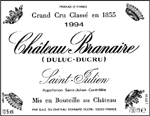
Classification: Fourth Growth in 1855
Owner: Marotteaux family
Administrator: Patrick Maroteaux
Address: 33250 St.-Julien-Beychevelle
Telephone: 05 56 59 25 86; Telefax: 05 56 59 16 26
E-mail: branaire@branaire.com
Website: www.branaire.com
Visits: Preferably by appointment, Monday to Friday, 9 A.M.–noon and 2–5 P.M.
Contact: Philippe Dhalluin
VINEYARDS
Surface area: 123.5 acres
Grape varietals: 70% Cabernet Sauvignon, 22% Merlot, 4% Cabernet Franc, 4% Petit Verdot
Average age of vines: 35 years
Density of plantation: 10,000 vines per hectare
Average yields: 48 hectoliters per hectare
Elevage: Three-week fermentation and maceration in temperature-controlled stainless-steel vats. Part of the yield undergoes malolactics in barrels. Eighteen to twenty-two months aging in barrels with 50% new oak. Fining with egg whites. Light filtration.
WINES PRODUCED
Château Branaire Ducru: 150,000–180,000 bottles
Château Duluc: 150,000 bottles
Plateau of maturity: Within 5–20 years of the vintage
During recent years, Branaire Ducru has improved discreetly but surely. Vintages from 1991 onward have been extremely consistent in quality, the wines exhibiting more depth, concentration, and stuffing while retaining the characteristic elegance and chocolaty spiciness of Branaire. A wine largely ignored by speculators, Branaire is favored by wine drinkers, which explains why it is rarely seen in auction sales. Because of this, prices remain reasonable. In the best vintages, Branaire Ducru can rival a third growth.
Note: Since 1991, the estate has benefitted from a state-of-the-art cellar where everything is operated by gravity. It was the first cellar in Bordeaux to be designed this way.
I have always found Branaire Ducru to be curiously underrated, undervalued, and somewhat forgotten whenever Bordeaux enthusiasts discuss their favorite wines. Travelers passing through St.-Julien have no doubt noted the indifferent beige building directly opposite Beychevelle on the Médoc’s main wine road. The finest vintages are magnificently scented, deep, rich wines that are as good as the other top wines of St.-Julien. Until the mid- to late 1990s, Branaire Ducru was no model of consistency, with a dubious series of indifferent wines produced in the 1980s. This may have reflected an overly abundant crop size and less than strict selections. The construction of a new cellar and the introduction of a new winemaking team, as well as a second label, appear to have been the necessary cures to get Branaire Ducru back on track, as evidenced by very strong efforts since the mid-1990s. One cannot underestimate Patrick Marotteaux, the energetic administrator, who is also the president of Bordeaux’s Union des Grands Crus.
The vineyards of Branaire Ducru, like those of many Bordeaux châteaux, are spread out in a morseled fashion throughout the commune of St.-Julien.
The wines of Branaire Ducru have a distinctive character. For a St.-Julien they are particularly spicy, with an almost exotic aroma of spice, oak, and vanilla. On the palate, the wine often has a pronounced, distinctive, chocolaty component that makes Branaire Ducru relatively easy to spot in blind tastings. This personality trait is especially noticeable in the great vintages of 2000, 1996, 1995, 1989, 1982, 1976, and 1975.
IMPORTANT VINTAGES
ANCIENT VINTAGES
One of the wines to search out is the 1975 (93 points; last tasted 9/02). This is one of the glorious successes of the vintage and easily has 10–15 more years of life to it. Other prominent successes include 1966, a wine that is probably now tiring.
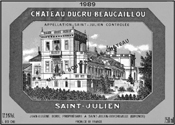
Classification: Second Growth in 1855
Owner: Borie family
Administrator: Bruno Borie
Address: 33250 St.-Julien-Beychevelle
Telephone: 05 56 73 16 73; Telefax: 05 56 59 27 37
Visits: By appointment only Monday to Friday, 9 A.M.–noon and 2–5 P.M. Closed in August and at harvest time.
Contact: François-Xavier Borie
VINEYARDS
Surface area: 128.4 acres
Grape varietals: 70% Cabernet Sauvignon, 25% Merlot, 5% Cabernet Franc
Average age of vines: 38 years
Density of plantation: 10,000 vines per hectare
Average yields: 49 hectoliters per hectare
Elevage: Seventeen to twenty-one-day fermentation and maceration in temperature-controlled stainless-steel and concrete tanks. Eighteen to twenty months aging in barrels with 50–65% new oak. Fining, light filtration upon bottling.
WINES PRODUCED
Château Ducru-Beaucaillou: 220,000 bottles
La Croix de Beaucaillou: 85,000 bottles
Plateau of maturity: Within 10–30 years of the vintage
GENERAL APPRECIATION
Ducru-Beaucaillou returned to form after a slump at the end of the 1980s and the beginning of the 1990s, when some of its wines were marred by aromas of wet cardboard, probably attributable to a TCA contamination in one of the aging cellars. Vintages from 1994 onward are on par with the best wines ever produced at the estate. Much like Branaire (to which it is superior) and Léoville Las Cases (which generally surpasses it), Ducru-Beaucaillou is rarely seen at auction. More a connoisseur’s buy than a speculator’s target, it is one of the most interesting Bordeaux super-seconds in terms of quality/price ratio.
Ducru-Beaucaillou, sitting among an outcropping of trees with a splendid view of the Gironde River, enjoys a picture-postcard setting. The property belongs to the Borie family. The late Jean-Eugène Borie was one of the Médoc’s few resident proprietors as well as one of the region’s great gentlemen. In the last three decades, he brought the quality of Ducru-Beaucaillou up to a level where vintages such as 2000, 1996, 1995, 1985, 1982, 1981, 1978, 1976, 1973, 1970, 1966, and 1961 could challenge any of the Médoc first growths. Passion for his wine, an obsessive commitment to quality, remarkable modesty, and numerous trips abroad as ambassador for Bordeaux made him one of this region’s most respected wine personalities. With his death several years ago, his son Xavier, who lives at Grand-Puy-Lacoste, assumed full control of Ducru until 2003 when his brother Bruno took over.
The wine of Ducru-Beaucaillou is the essence of elegance, symmetry, balance, breed, class, and distinction. It is never one of the most robust, richest, or fruitiest wines of St.-Julien and by its nature is a stubbornly slow developer. Most of the finest vintages of Ducru-Beaucaillou usually take at least 10 years to reveal their stunning harmony of fruit and power. Ducru-Beaucaillou is a great wine for a number of reasons. The meticulous attention to detail, the brutal selection process—whereby only the finest grapes and finest barrels of wine are permitted to go into the bottle—and the conservative viticultural practices followed, all play major roles in the success of this wine.
That being said, Ducru-Beaucaillou had a problem with the vintages between 1987 and 1990. All of my tasting notes reflect the fact that many bottles from these vintages had a musty component in the aromatics, probably attributable to some noxious aromas given off by the insulation in the old chai at Ducru. This chai was completely rebuilt and the source for the off smells eliminated. This problem, which does not affect all bottles of these vintages (1990, 1989, and 1988), has been eradicated. Because of these defects, I have not included these vintages in the tasting notes.
Ducru-Beaucaillou is one of Bordeaux’s most expensive second growths, reflecting the international demand for the wine and the consistently high quality.
IMPORTANT VINTAGES
ANCIENT VINTAGES
In the 1970s, the 1978 was one of the stars of the vintage and was still in great shape when last tasted (rated 90 in 5/02). Another terrific wine is the 1970, now beginning its decline. This wine (which I have rated as high as 92–93 when last drunk in 3/99) is a classic Ducru-Beaucaillou with great finesse, complexity, and elegance that is textbook St.-Julien. However, the wine requires consumption now.
In the 1960s, Ducru-Beaucaillou turned in competent efforts in 1966 and 1962, but probably the greatest Ducru-Beaucaillou I ever tasted was the 1961, last tasted in 1999 and in serious decline. At one time, this was among the highest rated Ducrus in my experience, rated 96 in 5/91. I am sure it is just a shadow of itself now, unless of course readers have access to pristinely stored magnums or even larger format bottles.
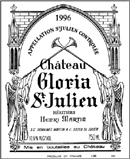
Classification: Cru Bourgeois
Owner: Françoise Triaud
Address: c/o Domaines Martin, 33250 St.-Julien-Beychevelle
Telephone: 05 56 59 08 18; Telefax: 05 56 59 16 18
Visits: By appointment only, Monday to Friday, 8 A.M.–noon and 2–6 P.M.
Contact: Corine Favereau
Surface area: 118.6 acres
Grape varietals: 65% Cabernet Sauvignon, 25% Merlot, 5% Cabernet Franc, 5% Petit Verdot
Average age of vines: 42 years
Density of plantation: 10,000 vines per hectare
Average yields: 50 hectoliters per hectare
Elevage: Prolonged fermentation and maceration in temperature-controlled tanks with pumpings over and pigéages. Fourteen months aging in barrels that are renewed by a third each year. Concentration by evaporation. Fining and filtration.
WINES PRODUCED
Château Gloria: 200,000 bottles
Château Peymartin: 50,000 bottles
Plateau of maturity: Within 5–10 years of the vintage
GENERAL APPRECIATION
Gloria’s wines are fruit-driven and supple, always soundly made and consistently reliable. Because Gloria is not classified (it was created in the 1940s, after the 1855 and 1932 classifications), its prices remain reasonable, but in terms of quality, it can rival a fourth or fifth growth in some vintages. This wine, which is much less expensive than most St.-Juliens, represents one of the best buys of the appellation, if not of the Médoc.
Gloria has always been used as an example of why the 1855 classification of the Médoc wines is so outdated. Not included in the original classification are wines Gloria has made (from vineyards purchased from neighboring classified châteaux) during the last 25 years that in vintages such as 2000, 1996, 1995, 1994, 1989, 1986, 1985, 1982, 1976, 1975, 1971, 1970, 1966, and 1961 are certainly as good as many of the wines produced by many of the classified growths. Shrewd merchants and consumers have long known Gloria’s quality, and the wine has been widely merchandised in America and abroad.
The late Henri Martin, Gloria’s owner, died in February 1991. He was one of the Médoc’s legendary figures. His wines were no doubt made for sheer crowd appeal. They were round, generous, and very ripe, with wonderful cedary, spicy, almost exaggerated bouquets. Nothing appears to have changed under the management of his son-in-law, Jean-Louis Triaud. The wines perform surprisingly well young but can age for up to 12–15 years. The Gloria style of the 1960s and early 1970s changed after the mid-1970s. Gloria vintages from 1978–1993 definitely appear to be wines that are lighter, more obviously fruity, and less tannic than those wines that were made previously. However, the 2000, 1996, and 1995 were clearly beefier, richer wines, perhaps foreshadowing a return to the pre-1978 style. Gloria remains, in either style, a gloriously exuberant, delicious St.-Julien that continues to sell at a price well below its actual quality level. On a cautionary note, several vintages of the late 1990s had an alarmingly high percentage of “corked” bottles.
2000 |
Dense ruby/purple, the 2000 Gloria is a very fat, ripe, seductive effort. An excellent, complex, evolved, and deliciously fruity effort, this medium-bodied 2000 exhibits sweet, herb-tinged, cassis fruit, cedar, and spice box notes along with abundant glycerin and flesh. This well-endowed Gloria should drink well between 2004–2015. Last tasted, 1/03. |
1998 |
This is an attractively fat, commercially styled, surprisingly soft 1998. It displays herb-tinged berry fruit, notes of saddle leather, and a medium-bodied, round finish. It should drink well for 5–6 years. Last tasted, 3/02. |
1996 |
One of the finest Glorias produced in recent vintages, the 1996 is uncommonly hedonistic, plump, and precociously styled. Low in acidity, rich in cedary, black currant fruit, medium bodied, and lush, it will provide delicious drinking young, yet will age for 10 years. Last tasted, 3/02. |
1995 |
The 1995 is lower in acidity and may not possess quite the density and power of the 1996, but readers looking for high-class Claret with immediate appeal would be foolish to pass it by. It, too, should be consumed within the next 10 years. Last tasted, 3/02. |
ANCIENT VINTAGES
For whatever reason, the 1990 and 1989 never lived up to be as good as those vintages’ reputations. Among my favorite Glorias of the past is the 1982 (89 points; last tasted 8/02). This wine has consistently been one of the most pleasant surprises of the vintage. Drinkable on release, drinkable in its youth, and drinkable in its full maturity, this wine exhibits gorgeous weedy, black currant fruits, full body, and a very luscious, fleshy mouth-feel. I would not push the wine much further, but certainly from pristine cellars, this wine is probably capable of lasting until at least 2005–2006. Although I have not tasted the wine in more than a decade, the 1970 was also a gorgeous wine, but I am sure it is now in decline.
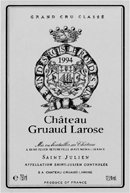
Classification: Second Growth in 1855
Owner: Bernard Taillan Vins (Merlaut family)
Address: 33250 St.-Julien-Beychevelle
Mailing Address: BP 6, 33250 St.-Julien-Beychevelle
Telephone: 05 56 73 15 20; Telefax: 05 56 59 64 72
E-mail: contact@chateau-gruaud-larose.com
Visits: By appointment only
Contact: Régine Peyrille
VINEYARDS
Surface area: 202.5 acres
Grape varietals: 57% Cabernet Sauvignon, 31% Merlot, 7.5% Cabernet Franc, 3% Petit Verdot, 1.5% Malbec
Average age of vines: 40 years
Density of plantation: 8,500–10,000 vines per hectare
Average yields: 50–60 hectoliters per hectare
Elevage: Fermentation at 31–33°C with indigenous yeasts and 21–35 day maceration in temperature-controlled concrete and wooden vats, with two daily pumpings-over. Half the yield undergoes malolactics in oak. Sixteen to eighteen months aging in barrels that are renewed by a third each year. No details regarding fining and filtration are forthcoming from the château.
WINES PRODUCED
Château Gruaud Larose: 300,000 bottles
Sarget de Gruaud Larose: 200,000 bottles
Plateau of maturity: Within 10–35 years of the vintage
GENERAL APPRECIATION
This can be one of the most massive and backward St.-Juliens. Since the mid-1990s, a more supple and elegant style has emerged. Unfortunately, some vintages still reveal excessive tannins in view of the fruit and stuffing of the wines. As a matter of fact, Gruaud’s recent track record is irregular—when the estate does well, it is consistent with its pedigree and often better, but a great effort is sometimes followed by one that is overly tannic and structured (i.e., 1998 and 1997; 1994 and 1993). Readers seeking Gruaud Larose for long-term aging (i.e., wines whose fruit will not fade before the tannins are fully melted) should be careful when picking a vintage. Prices are equivalent to those of most Bordeaux second growths.
For decades, Gruaud Larose produced St.-Julien’s most massive and backward wine. Under the new proprietor, Jacques Merlaut, there has been an obvious trend to produce a more refined, less rustic and tannic style of Gruaud. Merlaut has invested significantly in this estate, establishing a computerization of all data from the estate’s 66 different parcels. In addition, an expensive drainage system was installed. I expect this recent winemaking direction to continue. The production is large and the quality consistently high. Gruaud Larose produced wines of first-growth quality in vintages such as 2000, 1990, 1986, 1985, 1983, 1982, and 1961. The beautiful château, which sits on the plateau of St.-Julien rather than riverside, is not likely to be seen unless the visitor to the Médoc turns off the main Route du Vin (D2) at the town of St.-Julien-Beychevelle and takes route D101 in a westerly direction.
Those critics of Gruaud Larose who found the wine too chunky, solid, and massive may want to revisit this wine now that it is taking on more finesse and elegance.
IMPORTANT VINTAGES
2001 |
Gruaud Larose’s, astringent tannin gives the 2001 a certain austerity. Does it possess sufficient substance and fat to cover the massive structure? A deep ruby/purple color is followed by aromas of underbrush, tar, mint, and black currants. The big framework is there, and the charm, flesh, and richness have begun to emerge. A medium to full-bodied wine. The 2001 is a deeper, richer wine than the charming 1999. I cannot see it ever performing up to the quality of the spectacular 2000. Anticipated maturity: 2008–2020. Last tasted, 1/03. |
This immense, opaque black/purple–colored, structured offering possesses high tannin, full body, and a broodingly backward personality (similar to the 2000 Léoville Barton) with immense extract, concentration, and power. This long-lived behemoth will require patience as it is the densest, most powerful and tannic wine made since the estate’s sumptuous 1990. Anticipated maturity: 2015–2030+. Last tasted, 1/03. |
|
1999 |
An exotic perfume of tapenade, new saddle leather, damp earth, black currants, cherries, and smoke jumps from the glass of this impressive, powerful 1999. Medium bodied with moderate tannin, this dark plum/ruby-colored St.-Julien requires another 1–2 years of cellaring. Anticipated maturity: 2005–2015. Last tasted, 3/02. |
1998 |
Gruaud Larose has fashioned an elegant, less rustic wine than previous vintages. The color is a healthy dark ruby/purple. The bouquet offers aromas of plums, black raspberries, and cassis. Stylish, with medium to full body, sweet tannin, and excellent purity as well as overall symmetry, it will drink well between 2004–2016. Last tasted, 3/02. |
1997 |
The 1997 Gruaud Larose is a soft, fleshy effort loaded with olive and licoricetinged, black cherry and cassis fruit. Smoky, new saddle leather notes also emerge as the wine sits in the glass. Offering excellent richness, medium body, moderate weight, low acidity, and soft tannin, it will provide delicious as well as surprisingly complex, savory drinking for 5–6 years. Last tasted, 1/02. |
1996 |
This is a stylish, surprisingly civilized, medium-bodied wine that, however, does not possess the muscle and power expected from both this terroir and vintage. It still possesses excellent density, as well as roasted herb, licorice, and black currant flavors intermixed with incense-like smells. The wine is medium to full-bodied, pure, rich, and forward, especially for a 1996. Anticipated maturity: 2004–2018. Last tasted, 3/02. |
1995 |
Revealing good grip and tannin, the 1995 Gruaud Larose exhibits a dark ruby color and a nose of sweet black cherries, licorice, earth, and spice. Rich, with medium to full body, high tannin, and subtle oak in the background, the 1995 is nearly as structured and tannic as the 1996. The two vintages are more similar than dissimilar. Anticipated maturity: 2007–2020. Last tasted, 3/02. |
1994 |
The 1994 has dropped much of its mid-palate sweetness and fatness, tastes herbaceous, and possesses a mouth-searing harsh, bitter tannin. Perhaps it remains dormant, but does it possess sufficient ripeness, fruit, and texture to balance out the tannins? I don’t think so. Anticipated maturity: 2006–2015. Last tasted, 3/02. |
1990 |
This wine continues to get better and better and is certainly one of the great successes in what is a profound vintage for Bordeaux. While the wine still tastes young, it is already complex, with so much sweet tannin and lavish fruit that it is impossible to resist, even though it probably will not hit its plateau of maturity for another 5–6 years. A stunning nose of licorice, earth, cedar, Provençal herbs, black currants, asphalt, and cherries soars from the glass. Full-bodied, opulent, with fabulous concentration, a seamless texture, and remarkable stuffing and power, this low-acid, thick, almost viscous wine can be drunk now or cellared for at least another two decades. For trivia buffs, this was the wine President Chirac served former President Clinton when he hosted Clinton in Paris at the famous Parisian bistro L’Ami Louis in June 1999. I know, because several days later President Chirac gave me the Legion of Honor. In his speech, he acknowledged the fact that President Clinton only wanted to “drink a wine rated highly by Robert Parker.” Anticipated maturity: now–2020. Last tasted, 9/02. |
Somewhat of a letdown when tasted side by side with the 1990, the dark garnet–colored 1989 Gruaud Larose offers up notes of cedar, tobacco leaf, red and black currants, and some hints of compost. The nose smells mature, on the palate it is relatively ripe and sweet, but then the wine seems to have plenty of tannin and toughness without that incredible, chewy mid-palate the 1990 possesses. The wine still seems somewhat disjointed, but there are plenty of good things to be found. Perhaps the real problem is that it just suffers in comparison to the profound 1990. Anticipated maturity: 2005–2018. Last tasted, 5/02. |
|
1988 |
Dark plum/garnet, with a powerful nose of licorice, roasted meats, smoke, and sweet berry and black currant flavors, this medium-bodied, relatively austere but robust and concentrated Gruaud Larose still seems like a young wine, and possibly will be longer-lived than its more renowned sibling, the 1989. There is an earthiness and underlying streak of herbaceousness, but there is plenty of depth, concentration, and power to this somewhat burly Gruaud Larose. Anticipated maturity: now–2025. Last tasted, 9/02. |
1986 |
Still tasting as if it were only 7–8 years of age, the dense, garnet/purple-colored 1986 Gruaud Larose is evolving at a glacial pace. The wine still has mammoth structure, tremendous reserves of fruit and concentration, and a finish that lasts close to a minute. The wine is massive, very impressively constituted, with still some mouth-searing tannin to shed. Decanting of one to two hours in advance seems to soften it a bit, but this is a wine that seems to be almost immortal in terms of its longevity. It is a great Médoc classic and certainly one of the most magnificent Gruaud Larose ever made. Anticipated maturity: 2006–2035. Last tasted, 10/02. |
1985 |
Fully mature, the dark garnet–colored 1985 exhibits notes of tapenade, earth, sweet berry, and black currant fruit, and possibly a hint of black truffles. The wine is lush, medium to full-bodied, and fleshy, with no hard edges. Sweet fruit, plenty of glycerin, and a very seductive style make for a very sumptuous, complex, fully mature Gruaud Larose. Anticipated maturity: now–2008. Last tasted, 8/02. |
1983 |
Beginning to show a few cracks around the edges, this once outstanding wine still has a very complex nose of roasted meats, cigar smoke, asphalt, licorice, and black, juicy cherries and currants. The wine’s succulence and fat, once one of its hallmarks, are beginning to dry out ever so slightly. The tannins and acids seem a bit more noticeable in the finish than I remember during its first 10–15 years of life. I would suspect this wine is still at its peak of perfection from magnum or bigger formats, but from regular bottle, even from my very cold cellar, this wine is starting to show some of the telltale signs of wear and tear. Anticipated maturity: now–2008. Last tasted, 8/02. |
1982 |
Along with the 1961, the 1982 is one of the two greatest Gruaud Laroses I have ever tasted. It needs decanting of a good one to two hours in advance not only for aeration purposes, but also to get it off of its very heavy sediment. The color remains a murky, opaque purple/garnet. The phenomenal nose smells like a Spanish tapas bar with notes of new saddle leather, licorice, tar, crème de cassis, olives, and grilled meats. Extremely full-bodied with a viscous texture, remarkable levels of glycerin, and fabulous concentration, the 1982 Gruaud Larose is still an adolescent in terms of its development. The finish is filled with extract and tannin in a large, massively scaled style. I misidentified this wine as a first growth when tasted blind . . . it is that compelling. Anticipated maturity: 2004–2025. Last tasted, 11/02. |
This property has an enviable track record, with excellent wines made in 1981 (88 points; last tasted 3/00), 1979 (88 points; last tasted 12/00), and even a successful 1975 (90? points; last tasted 2/02). The latter wine still has an excess of tannin, but the sheer concentration and power of the wine remains unchanged. This is the kind of wine that most people will probably give up on, but we will not really know if it is ever going to achieve greatness until about 2020. Nevertheless, I am still an optimist, and I hope I am alive to see it hit its plateau of maturity. It is probably available for a song since most people have given up on it, but this wine still tastes relatively young, just very tannic. The 1970 was somewhat of a disappointment, but Gruaud Larose made excellent wines in 1966, 1964, 1962, and, of course one of their all-time greats, the 1961 (that wine was last tasted on New Year’s Day 2001, and was still a fabulous wine that I would rate 96). Except for the 1949, I have not tasted any of the historic vintages since the last edition of this book, but pristine bottles, preferably in magnums or bigger, of the 1955 (90, last tasted 3/98), 1953 (93, last tasted 3/98), 1949 (90?, last tasted 1/02), 1945 (96+, last tasted 10/94), and 1928 (97, last tasted 10/94) might well be worth their high cost of admission, given how stunning they were when I last had them.
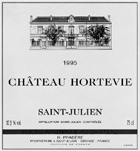
Classification: Cru Bourgeois
Owner: Henri Pradère
Address: 33250 St.-Julien-Beychevelle
Telephone: 05 56 59 06 27; Telefax: 05 56 59 29 32
No visits
VINEYARDS
Surface area: 8.6 acres
Grape varietals: 70% Cabernet Sauvignon, 25% Merlot, 5% Petit Verdot
Average age of vines: 40 years
Density of plantation: 10,000 vines per hectare
Average yields: 50 hectoliters per hectare
Elevage: Three week fermentation and maceration in temperature-controlled stainless-steel vats. Twenty months aging in oak barrels that are renewed by 25% each year. Fining, no filtration.
WINES PRODUCED
Château Hortevie: 18,000 bottles
No second wine is produced.
Plateau of maturity: Within 3–10 years of the vintage
This well-made wine, worth a Cru Bourgeois Exceptionnel, remains reasonably priced and represents a good value among St.-Juliens. Unfortunately, the production is very small.
The tiny production of Hortevie comes from a vineyard of Henri Pradère, who also owns Terrey-Gros-Cailloux. Although both these wines are made by identical methods from the same vineyard, Hortevie is said to be produced from older vines and is treated as somewhat of a tête de cuvée of Terrey-Gros-Cailloux. Pradère’s tendency to pick late has always resulted in rich, concentrated, low-acid wines that begged for some structure from new oak casks. These were finally introduced at Hortevie in the late 1980s, although much of the production of both Hortevie and Terrey-Gros-Cailloux is still aged in tank until the proprietor deems it ready for bottling. Hortevie is a consistently good St.-Julien and has long represented a fine value. While not long-lived, the top vintages, such as 1996, 1995, 1989, 1986, and 1982, are capable of aging well for 10–15 years.
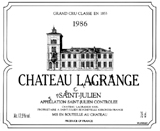
Classification: Third Growth in 1855
Owner: Château Lagrange SA (Suntory)
Address: 33250 St.-Julien-Beychevelle
Telephone: 05 56 73 38 38; Telefax: 05 56 59 28 09
E-mail: chateau-lagrange@chateau-lagrange.com
Website: www.chateau-lagrange.com
Visits: By appointment Monday to Thursday, 9–11 A.M. and 2–4 P.M.
Contact: Marcel Ducasse
VINEYARDS
Surface area: 269.2 acres
Grape varietals: 66% Cabernet Sauvignon, 27% Merlot, 7% Petit Verdot
Average age of vines: 25 years
Density of plantation: 8,500 vines per hectare
Average yields: 58 hectoliters per hectare
Elevage: Fermentation at 28°C and three-week maceration in temperature-controlled stainless-steel tanks. Twenty months aging in barrels with 60% new oak. Fining and filtration.
WINES PRODUCED
Château Lagrange: 300,000 bottles
Les Fiefs de Lagrange: 450,000 bottles
Plateau of maturity: Within 7–15 years of the vintage
After producing mediocre wines in the 1960s and 1970s, Lagrange had improved spectacularly after its acquisition by Japan’s Suntory. Lagrange merits its present classification and represents a reasonably good value, given the fact that it remains less renowned than its more famous siblings of St.-Julien.
Prior to 1983, Lagrange (a third growth) had suffered numerous blows to its reputation as a result of a pathetic track record of quality in the 1960s and 1970s. The well-situated vineyards represent a rare unmorseled property adjacent to Gruaud Larose so there was no reason why good wine should not have been produced.
In 1983 the huge Japanese company Suntory purchased Lagrange and began an extraordinary renovation of not only the château and the chais, but also the vineyards. No expense has been spared, and such talented people as administrator Marcel Ducasse and the property’s young, enthusiastic oenologist, Kenji Suzuta, have begun to make stunning wines in an amazingly short period of time.
Not only has the quality of the wines been upgraded, but Lagrange is now a beautiful château with tranquil gardens and a lake teeming with swans and ducks.
If vintages from 1985 on reveal any particular style, it is one that favors an impressive depth of flavor welded to plenty of tannin, toasty new oak, and an underlying succulence and fatness that is no doubt due to a strict selection and the harvesting of very ripe fruit with an element of sur-maturité. Clearly the new proprietors seem intent on producing a wine that can age for 20 or more years, yet have appeal when young.
While the world press has applauded the extraordinary turnaround made at Château Margaux by the Mentzelopoulos family, less has been written about the turn of events at Château Lagrange, although in 1990 The Wall Street Journal, amazingly, ran a front-page story about this showpiece property. Nevertheless, this wine currently remains considerably underpriced given the quality level of the wines that have emerged.
IMPORTANT VINTAGES
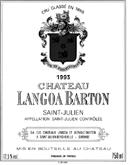
Classification: Third Growth in 1855
Owner: Barton family
Address: 33250 St.-Julien-Beychevelle
Telephone: 05 56 59 06 05; Telefax: 05 56 59 14 29
Visits: By appointment Monday to Thursday, 9–11 A.M. and 2–4 P.M.
Contact: Maud Pinto
VINEYARDS
Surface area: 42 acres
Grape varietals: 70% Cabernet Sauvignon, 20% Merlot, 10% Cabernet Franc
Average age of vines: 30 years
Density of plantation: 9,000 vines per hectare
Average yields: 50 hectoliters per hectare
Elevage: Fifteen to twenty-one-day fermentation and maceration in temperature-controlled wooden vats of 200 hectoliter capacity. Twenty months aging in barrels with 50% new oak. Fining and filtration.
WINES PRODUCED
Château Langoa Barton: 90,000 bottles
Lady Langoa: 30,000 bottles
Plateau of maturity: Within 8–22 years of the vintage
GENERAL APPRECIATION
One of the least known of Bordeaux classified growths, Langoa is overshadowed by its more prestigious stablemate Léoville Barton. Often overly tannic and backward, it is less charming than most St.-Juliens. All in all, Langoa is a good buy, but only for patient consumers . . . or gamblers.
Langoa Barton is an impressively large château that sits directly on the well-traveled D2, or Médoc Route du Vin. The wine of the well-known second-growth Léoville Barton is also made in the château’s cellars. Both Langoa and Léoville Barton are the properties of Anthony Barton, an Irishman whose family has had an interest in the Bordeaux area since 1821.
The late Ronald Barton and now his handsome nephew Anthony have produced top-class wine that critics have called uncompromisingly traditional and classic. Both are St.-Juliens with a distinctive Pauillac character and personality. Since the wines are made in the same wine cellar, by the same staff, the first question someone always asks is how they differ. In most years, Léoville Barton surpasses the quality of Langoa. Both are big, ripe, concentrated, spicy wines that frequently lack the youthful suppleness and commercial up-front charm of some of their neighbors. Nevertheless, they age extremely well and when mature combine the savory, complex, graceful fruitiness of St.-Julien with the cedary toughness and virility of Pauillac.
Rarely has Léoville nor Langoa Barton enjoyed the reputation of Léoville Las Cases and Ducru-Beaucaillou. That has changed since Anthony Barton has had full responsibility for the property, taking over when his uncle Ronald died in 1986. A stricter selection and the increased usage of new oak were immediately noticeable. These moves, plus a hard-headed, refreshingly realistic view that wine is not really sold until the consumer buys a bottle and drinks it, have all combined to make Langoa Barton and Léoville Barton grossly underpriced, particularly now that the quality level is close to the “super-second” level.
My only criticism of Langoa Barton and Léoville Barton is that in some of the lighter Bordeaux vintages such as 1979, 1974, 1973, and 1971 the wines of these two châteaux taste less successful than many of their peers.
IMPORTANT VINTAGES
ANCIENT VINTAGES
Langoa Barton rarely appears at the auction market, but some of the vintages that I have had good experience with have been the 1970, 1961, 1959, 1953, 1952, and 1948. The greatest Langoa Barton I have ever tasted in my life was the 1948, which was rated 93 in March 1995.
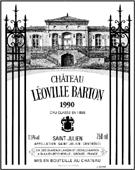
Classification: Second Growth in 1855
Owner: Barton family
Address: 33250 St.-Julien-Beychevelle
Telephone: 05 56 59 06 05; Telefax: 05 56 59 14 29
E-mail: chateau@leoville.barton.com
Visits: By appointment only
Contact: Maud Pinto
VINEYARDS
Surface area: 118.6 acres
Grape varietals: 72% Cabernet Sauvignon, 20% Merlot, 8% Cabernet Franc
Average age of vines: 30 years
Density of plantation: 9,000 vines per hectare
Average yields: 50 hectoliters per hectare
Elevage: Fifteen to twenty-one-day fermentation and maceration in temperature-controlled wooden vats of 200 hectoliter capacity. Twenty months aging in barrels with 50% new oak. Fining and filtration.
WINES PRODUCED
Château Léoville Barton: 264,000 bottles
La Réserve de Léoville Barton: 70,000 bottles
Plateau of maturity: Within 10–30 years of the vintage
GENERAL APPRECIATION
Since 1985, Léoville Barton has unquestionably improved and its pricing (except for the 2000) has not yet followed the quality curve, which is good news. One of the best buys among the super-seconds, this wine is, however, tannic and needs considerable time to fully express itself. While Léoville Barton rarely attains the level of Léoville Las Cases, the unrivaled St.-Julien, it is much less expensive.
Léoville Barton is generally acknowledged to have a huge qualitative edge on its sibling, Langoa Barton. Both properties are owned by Anthony Barton. Unlike other proprietors, Barton uses only a small amount of the supple, fleshy Merlot in the blend (although it has been increased to 20% with plantings in the mid-1980s), whereas the proportion of Cabernet Sauvignon is high not only for the commune of St.-Julien, but for the Médoc in general.
Léoville Barton is made at Langoa Barton because there is no château at Léoville. The main vineyard for Léoville Barton sits immediately behind the town of St.-Julien-Beychevelle and runs in a westerly direction, where it intersects with the large vineyard of Château Talbot.
The inconsistencies of the 1970s have been replaced by a consecutive string of brilliantly successful wines in the 1980s and 1990s. Since 1985 Anthony Barton has refined rather than changed the traditional style of this wine. Among all the top wines of St.-Julien, it represents the finest value.
IMPORTANT VINTAGES
ANCIENT VINTAGES
There is no question that, under Anthony Barton, this estate has been far more consistent than in the past. Nevertheless, there are some great wines to keep an eye out for, including a fabulous 1975 (now fully mature, but one of the most successful wines in the Médoc; rated 90 when last tasted 12/00). The 1970 can often hit the peak, but seems very irregular from bottle to bottle. Among the vintages of the 1960s, the fabulous 1961 stands out (92 points; last tasted 9/97). Even better than the 1961, but hard to know how good it would be today unless it was tasted out of pristinely stored magnums or larger formats, was the 1959 (94 points; last tasted 10/94). The 1953 is also glorious (95 points; last tasted 10/94), and of course in the late 1940s, Léoville Barton made some magnificent wines, including 1949 (95 points; last tasted 10/94), 1948 (one of the highest rated with 96 points; last tasted 10/94), and of course, probably the greatest Léoville Barton I have ever tasted, the 1945 (98 points; last tasted 10/94). I am sure these wines are still profound if they have been stored properly, as the great vintages of Léoville Barton seem capable of lasting 25–50 years or more.

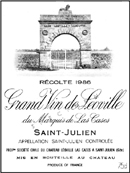
Classification: Second Growth in 1855
Owner: SC du Château Léoville Las Cases (Delon family)
Address: 33250 St.-Julien-Beychevelle
Telephone: 05 56 73 25 26; Telefax: 05 56 59 18 33
E-mail: leoville-las-cases@wanadoo.fr
Website: (under construction)
Visits: By appointment only
Contact: Jacqueline Marange
VINEYARDS
Surface area: 240 acres
Grape varietals: 65% Cabernet Sauvignon, 19% Merlot, 13% Cabernet Franc, 3% Petit Verdot
Average age of vines: 30 years
Density of plantation: 8,000 vines per hectare
Average yields: 42–50 hectoliters per hectare
Elevage: Twelve to twenty-day fermentation and maceration in temperature-controlled wooden, concrete, and stainless-steel vats. Twelve to twenty-four-months aging in barrels with 50–100% new oak depending upon the vintage. Fining, no filtration.
WINES PRODUCED
Château Léoville Las Cases: 216,000 bottles
Clos du Marquis: 240,000 bottles
Plateau of maturity: Within 8–30 years of the vintage
GENERAL APPRECIATION
Léoville Las Cases, the undisputed King of the St.-Julien, is one of the few Bordeaux classified growths that may be bought blindly year after year. Consistently of first-growth quality, this wine’s track record has been remarkable in the 1980s and 1990s. Over recent years, it has turned toward a more elegant style while retaining its characteristic richness, depth, structure, and close-to-perfect equilibrium. Despite the fact that it is the most expensive St.-Julien, Las-Cases’ pricing remains within acceptable limits. It is not a speculator’s wine and is rarely seen at auctions. At consumer level, it is less expensive than the first growths but often equal in quality. The second wine of the estate, Clos du Marquis, is very good and in the best vintages competes favorably with third and fourth growths.
Léoville Las Cases is unquestionably one of the great names and wines of Bordeaux. Situated next to Latour, Léoville Las Cases’ main vineyard of more than 100 acres is the picturesque, enclosed vineyard depicted on the wine’s label. The estate is one of Bordeaux’s largest, and while the meticulous and passionate commitment to quality may be equaled by several others, it is surpassed by no one. The man responsible was the late Michel Delon, and more recently, his son Jean-Hubert. Michel Delon was a proud man who was as admired as he was scorned. A perfectionist, his critics, and there were many, claimed he played games when selling his wines, doling out tiny quantities in great vintages to artificially drive up the price. Yet no one can argue about the splendid quality of his wines, the product of an almost maniacal obsession to be the finest, not just in St.-Julien, but in the entire Médoc! Who else would declassify more than 50% of their crop in an abundant vintage such as 1986 or an astonishing 67% in 1990? Who else would introduce not only a second wine, but a third wine (Bignarnon) as well? Who else would lavishly install marble floors in the air-conditioned chais? Like him or not, Michel Delon, ably assisted by Michel Rolland (not the Libourne oenologist) and Jacques Depoizier, consistently made one of the greatest wines in the Médoc during the 1980s and 1990s. His son seems more than capable of continuing in the path of his father.
The wines of Léoville Las Cases were erratic in the post–World War II era, yet the period from 1975 onward has witnessed the production of a string of successes that have come close to perfection in vintages such as 2000, 1996, 1995, 1994, 1990, 1986, 1985, 1982, 1978, and 1975. In fact, these wines are as profound as most of the Médoc’s first growths in those vintages.
In comparison to Ducru-Beaucaillou, its chief rival in St.-Julien, the wines of Léoville Las Cases tend to be a shade darker in color, more tannic, larger scaled, more concentrated, and of course, built for extended cellaring. They are traditional wines, designed for connoisseurs who must have the patience to wait the 10–15 years necessary for them to mature properly. Should a reclassification of Bordeaux’s 1855 classification take place, Léoville Las Cases, like Ducru-Beaucaillou and possibly Léoville Barton and Gruaud Larose, would merit and receive serious support for first-growth status.
IMPORTANT VINTAGES
ANCIENT VINTAGES
Léoville Las Cases’ record between 1975 and 1981 is very impressive, often with some of the best wines of the vintage, such as 1981 (89 points; last tasted 7/00), 1978 (90 points; last tasted 2/02), and of course, the 1975, a blockbuster that still has an excess of tannin but has a tremendous wealth of fruit and concentration (92? points; last tasted 3/02). The early 1970s were largely disappointing, including the 1970. In the 1960s, the 1966 (89 points; last tasted 5/95) and 1962 (88 points; last tasted 5/95) are the two top vintages. I tasted the 1961 several times (87 points; last tasted 3/99) with Michel Delon and simply thought it was not nearly the wine it should have been for the vintage. I actually preferred the 1959 (88 points; last tasted 3/99).
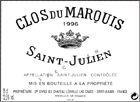
The Clos du Marquis, the second label of Léoville Las Cases, was created at the end of the 19th century. This name, which has been used on a regular basis since the beginning of the last century, originates from the small “clos” (walled parcel) situated near the Château de Léoville (the residence of the late marquis de Las-Cases).
Clos du Marquis could be considered the precursor of the Bordeaux second wines, a movement that generally took hold in the mid- to late 1980s. It has always been made from the younger vines, or cuvées deemed of insufficient quality for the grand vin.
However, with time, the Clos du Marquis has acquired an identity of its own. Today the wine emerges from well-defined terroirs situated outside the Grand Clos de Las Cases and within the Petit Clos. These selected vineyards are surrounded by those of Pichon-Lalande, Léoville Poyferré, Léoville Barton, Lagrange, and Talbot.
Since 1989, Clos du Marquis has been close to the quality of a third or fourth growth.
IMPORTANT VINTAGES (CLOS DU MARQUIS)
2001 |
The powerful, concentrated 2001 Clos du Marquis is not dissimilar from its bigger sibling. This dense purple–colored offering exhibits admirable purity, medium body, abundant quantities of sweet fruit, and ripe tannin. It should drink well between 2004–2015. Last tasted, 1/03. |
2000 |
The compelling 2000 Clos du Marquis exhibits a deep ruby/purple color along with aromas and flavors of cherries and cassis. Its textbook style reveals elegance, purity, and overall harmony. Rich, medium bodied, and moderately tannic, it will be at its peak between 2004–2020. It is the greatest Clos du Marquis ever made! Last tasted, 1/03. |
1999 |
The 1999 Clos du Marquis reveals sweet black currant fruit on the attack, but the finish is tannic and compressed. Drink it over the next decade. Last tasted, 3/02. |
A superb effort, the 1998 exhibits abundant quantities of black currant and cherry fruit subtly dosed with toasty oak. A medium to full-bodied, nicely textured, pure effort, with a moderately tannic finish, it resembles Léoville Las Cases but without the weight, overall length, and power. Anticipated maturity: now–2014. Last tasted, 3/02. |
|
1996 |
A terrific Clos du Marquis and clearly of second- or third-growth quality, this dark purple–colored wine reveals much of its bigger sibling’s structure, brooding backwardness, and rich, expansive character. The wine is less massive than Léoville Las Cases, but exhibits plenty of sweet kirsch black currant fruit intermixed with high quality, subtle new oak, and steely, mineral characteristics. Rich and medium to full-bodied with ripe tannin, this is a dazzling Clos du Marquis. Anticipated maturity: now–2018. Last tasted, 1/01. |
1995 |
The outstanding 1995 Clos du Marquis is the quintessentially elegant style of Las-Cases, with copious quantities of sweet fruit, outstanding depth, ripeness, and overall equilibrium, but no sense of heaviness. Like so many of this estate’s great wines, everything is in proper proportion, with the acidity, alcohol, and tannin well integrated. The 1995 is slightly more up-front and precocious than the 1996; it can be drunk now as well as over the next 10 years. Last tasted, 1/01. |
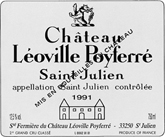
Classification: Second Growth in 1855
Owner: GFA Domaine St.-Julien
Address: 33250 St.-Julien-Beychevelle
Telephone: 05 56 59 08 30; Telefax: 05 56 59 60 09
E-mail: lp@leoville-poyferre.fr
Website: www.leoville-poyferre.fr
Visits: By appointment Monday to Friday, 9 A.M.–noon and 2–5:30 P.M.
Contact: Didier Cuvelier
VINEYARDS
Surface area: 197.6 acres
Grape varietals: 65% Cabernet Sauvignon, 25% Merlot, 8% Petit Verdot, 2% Cabernet Franc
Average age of vines: 25 years
Density of plantation: 8,000 vines per hectare
Average yields: 45–50 hectoliters per hectare
Elevage: Seven-day fermentation and 15–30 day maceration in temperature-controlled tanks. Twenty-two months aging in barrels with 75% new oak. Fining with egg whites, no filtration.
WINES PRODUCED
Château Léoville Poyferré: 250,000 bottles
Moulin Riche: 130,000 bottles
Plateau of maturity: Within 8–20 years of the vintage
The least well-known of the three Léovilles, Poyferré had an irregular track record until the end of the 1980s, but has slowly begun to achieve parity with its two more prestigious siblings. Improvements have been noticeable since the beginning of the 1990s.
Talk to just about any knowledgeable Bordelais about the potential of the vineyard of Léoville Poyferré, and they will unanimously agree that Poyferré has the soil and capacity to produce one of the Médoc’s most profound red wines. In fact, some will argue that Léoville Poyferré has better soil than any of the other second-growth St.-Juliens. But the story of Léoville Poyferré since 1961, while largely one of disappointments, has the makings of a happy ending. Modernizations to the cellars, the introduction of a second wine, the elevated use of new oak, the increasingly watchful eyes of Didier Cuvelier, and the genius of the Libourne oenologist, Michel Rolland, have finally pushed Léoville Poyferré into the elite of St.-Julien. The two finest vintages of the 1980s remain the gloriously fruity 1983 and the prodigious 1982. Both years exhibit the depth and richness that this property is capable of attaining. In the 1990s, a top 1990 followed by strong efforts in 2000, 1996, and 1995 suggest this estate has begun to finally exploit its considerable potential.
IMPORTANT VINTAGES
ANCIENT VINTAGES
Léoville Poyferré had a dreadful record in the 1970s, with most vintages meriting scores between the mid-60s and the low 80s. The record in the 1960s was even more pathetic, except for a very good 1961 (87 points; last tasted 9/99 in a horizontal tasting). Of the museum pieces considered great, none of the highly rated vintages in Bordeaux have ever produced a Léoville Poyferré that I would rate higher than the mid-80s, and that includes 1959, 1955, 1953, and 1945.
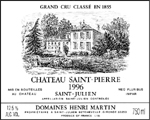
Classification: Fourth Growth in 1855
Owner: Françoise Triaud
Address: c/o Domaines Martin, 33250 St.-Julien-Beychevelle
Telephone: 05 56 59 08 18; Telefax: 05 56 59 16 18
Visits: By appointment only Monday to Friday, 8 A.M.–noon and 2–6 P.M.
Contact: Corinne Favereau
VINEYARDS
Surface area: 42 acres
Grape varietals: 75% Cabernet Sauvignon, 15% Merlot, 10% Cabernet Franc
Average age of vines: 42 years
Density of plantation: 10,000 vines per hectare
Average yields: 50 hectoliters per hectare
Elevage: Prolonged fermentation and maceration in temperature-controlled stainless-steel vats with four daily pumpings-over and pigéages. Concentration by evaporation. Fourteen months aging in barrels that are renewed by half at each vintage. Fining and filtration.
WINES PRODUCED
Château Saint-Pierre: 60,000 bottles
Plateau of maturity: Within 7–20 years of the vintage
GENERAL APPRECIATION
One of the most underestimated classified growths of Bordeaux, Saint-Pierre is of good quality, though some of the recent vintages too frequently exhibit aromas of cardboard/wet concrete.
Saint-Pierre is the least known of the classified-growth St.-Julien châteaux. Much of the production of Saint-Pierre has traditionally been sold to wine enthusiasts in Belgium, no doubt because the former owners, Monsieur Castelein and Madame Castelein-Van den Bussche, were Belgian. In 1982 one of the Médoc’s great personalities, the late Henri Martin, purchased the property.
The vineyards of Saint-Pierre are well located right behind the town of St.-Julien-Beychevelle, and a drive past them will reveal a high percentage of old and gnarled vines, always a sign of quality. The style of wine of Saint-Pierre has tended to be rich, corpulent, chunky, and full-bodied, even thick and coarse in some vintages. Always deeply colored, sometimes opaque, Saint-Pierre is a big, rustic, dusty-textured wine. While it can lack the finesse and charm of many St.-Juliens, such as Ducru-Beaucaillou and Léoville-Las Cases, it compensates for that deficiency with its obvious (some would say vulgar) display of power and muscle.
Assuming the corky bottles so evident in the late 1990s are not symptomatic of a more serious problem in the cellars, the wines of Saint-Pierre, when compared with those of the top châteaux of St.-Julien, are vastly underrated. This estate continues to languish in the shadows cast by the glamorous superstars of the St.-Julien appellation. Given the usually realistic price, consumers should put this lack of recognition to good use.
IMPORTANT VINTAGES
2001 |
A strong effort from Saint-Pierre, this excellent 2001 exhibits a saturated ruby/purple color and sweet aromas of black currants and damp foresty notes. Medium bodied with great fruit on the attack and a dry, moderately tannic finish displaying impressive purity, it will be at its finest between 2007–2017. Last tasted, 1/03. |
2000 |
Smoky and earthy with copious jammy cassis fruit and sweet tannin, this is an excellent, full-bodied Saint-Pierre. The saturated deep purple color is followed by a persistent, concentrated wine with copious sweet tannin. Three bottles tasted revealed no traces of wet cardboard. Anticipated maturity: 2007–2020. Last tasted, 1/03. |
1999 |
Soft, briery, berry fruit intermixed with herbs, earth, and spice box are moderately intense. Low in acidity with sweet tannin and fleshy fruit, this medium-bodied, tasty, flavorful St.-Julien should be drunk during its first 10–12 years of life. Last tasted, 3/02. |
1998 |
Sixty percent, or three out of five bottles that I have tasted of this wine have been marred by a corked character. This has me spooked with respect to what this wine might be. Certainly the healthy examples of 1998 Saint-Pierre have exhibited a deep ruby/purple color and notes of dried herbs intermixed with underbrush, black currant, and compost. The wine is tannic, somewhat austere, and angular, but classic, if that means a typical, rather leanly styled Bordeaux. Anticipated maturity: 2006–2016. Last tasted, 3/02. |
1996 |
Just emerging from a relatively disjointed, awkward stage, this dark ruby/purple–colored wine offers up notes of new saddle leather, a hint of chocolate, black currants, and earth. The wine is medium bodied, relatively tannic, yet has good underlying sweetness. It still seems a bit disjointed and potentially too austere, but time will tell. Anticipated maturity: 2007–2020. Last tasted, 3/02. |
1995 |
Dark ruby with some sweet, herbaceous, cherry, and black currant notes intermixed with licorice and herb, this ripe, medium-bodied wine seems to finish a bit quickly on the palate. Anticipated maturity: 2004–2014. Last tasted, 3/02. |
From barrel this wine showed relatively good opulence and almost too much new oak, but from bottle the wine showed some hard tannins, medium body, some spicy, herb-tinged black currant fruit, and an angular finish. Anticipated maturity: 2005–2012. Last tasted, 3/02. |
|
1990 |
One of the best Saint-Pierres I have ever tasted, this dense ruby/purple–colored wine seems to be approaching full maturity. With a big, sweet nose of vanilla, smoke, black cherry, and currant jam intermixed with some tobacco and licorice, this opulent, full-bodied wine is fleshy, low in acidity, and a treat to drink. Anticipated maturity: now–2012. Last tasted, 3/02. |
1989 |
Showing some amber at its rim, this dark garnet–colored wine is another low-acid, chewy, lush mouthful of wine with notes of licorice, fruitcake, spice box, and sweet currant fruit. The wine has relatively high alcohol, low acidity, and some moderate tannins still lingering in the finish. Nevertheless, I would drink it over the next decade. Last tasted, 3/02. |
1988 |
This wine has evolved nicely, showing a classic Bordeaux nose of fruitcake, cedar, licorice, tobacco, and black currants. Medium bodied with moderate tannin yet excellent concentration, this wine should continue to develop and last where well stored. Anticipated maturity: now–2008. Last tasted, 3/02. |
1986 |
Still powerful, backward, muscular, and concentrated, with high tannin and some earthy, leathery, cherry, and black currant fruit notes, this brawny, relatively muscular, corpulent wine is a bit rustic but still impressive. Anticipated maturity: now–2015. Last tasted, 3/02. |
1985 |
Fully mature, this relatively spicy wine has a medium ruby color with some considerable pink at the edge. The wine exhibits licorice, weedy black currants, and a spiciness to its open-knit, moderately endowed flavors. Drink it over the next 5–6 years. Last tasted, 11/00. |
1982 |
Fully mature, the 1982 has a dark garnet color with some amber creeping in at the edge. The wine offers up a big, smoky nose with licorice, cigar box, cedar, and sweet cherry and black currant fruit. The wine is lush, medium to full-bodied, low in acidity, and very expansive and user-friendly. Anticipated maturity: now–2007. Last tasted, 9/02. |
ANCIENT VINTAGES
Saint-Pierre has a relatively consistent record, with very strong efforts in 1970 (88 points; last tasted 1/02) and 1961 (87 points; last tasted 7/85).
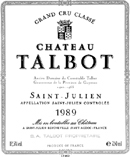
Classification: Fourth Growth in 1855
Owner: Lorraine Rustmann Cordier and Nancy Bignon Cordier
Address: 33250 St.-Julien-Beychevelle
Telephone: 05 56 73 21 50; Telefax: 05 56 73 21 51
E-mail: chateau-talbot@chateau-talbot.com
Website: www.chateau-talbot.com
Visits: By appointment Monday to Friday, 9–11 A.M. and 2–4:30 p.m. (Friday afternoons, until 3 P.M.)
Contact: Marisol Compadre
Surface area: 252 acres
Grape varietals: 66% Cabernet Sauvignon, 26% Merlot, 5% Petit Verdot, 3% Cabernet Franc
Average age of vines: 35 years
Density of plantation: 7,700 vines per hectare
Average yields: 52 hectoliters per hectare
Elevage: Three-week fermentation and maceration in temperature-controlled stainless-steel and wooden vats. Fifteen months aging in barrels with 40% new oak. Fining, light filtration.
WINES PRODUCED
Château Talbot: 300,000 bottles
Connétable de Talbot: 300,000 bottles
Plateau of maturity: Within 7–25 years of the vintage
GENERAL APPRECIATION
Talbot is consistently of high quality and represents one of the best buys of the Médoc. Vintages such as 1986 and 1982 remain the reference point for how great this wine can be.
The huge single vineyard of Talbot is situated inland from the Gironde River, well behind the tiny hamlet of St.-Julien-Beychevelle and just north of Gruaud Larose.
Talbot is named after the English commander John Talbot, Earl of Shrewsbury, who was defeated in battle at Castillon in 1453. The château made consistently fine, robust, yet fruity, full-bodied wines under the Cordier administration and deserved promotion should any new reclassification of the wines of the Médoc be done. The new administration appears to be moving in the direction of a softer, more elegant style, with more consistency from vintage to vintage.
A modest amount of delicious, dry white wine is made at Talbot. Called Caillou Blanc du Château Talbot, it is a fresh, fragrant white—one of the finest produced in the Médoc. It must, however, be drunk within 2–4 years of the vintage.
IMPORTANT VINTAGES
ANCIENT VINTAGES
Talbot has a relatively distinguished record for producing very good wines in just about every reasonably good vintage Bordeaux had in the 1970s. The 1978 (87 points; last tasted 6/99), 1975 (87? points; last tasted 11/01), and 1971 (87 points; last tasted 3/00) are all fine efforts. In the 1960s, Talbot had to take a backseat to its sister château, Gruaud Larose. Gruaud Larose consistently produced a far better wine than Talbot in the top vintages of 1966, 1962, and 1961. Recently, I have not tasted any of the Talbots from those vintages. Perhaps the greatest two ancient vintages of Talbot I have tasted, although I have not had them in many years, is the 1953 Talbot (90 points; last tasted 12/95) and 1945 (94 points; last tasted 3/88).
OTHER ST.-JULIEN ESTATES
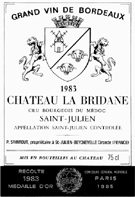
Classification: Cru Bourgeois
Owner: Bruno Saintout
Address: 33250 St.-Julien-Beychevelle
Mailing Address: c/o SCEA de Cartujac, 33112 Saint-Laurent de Médoc
Telephone: 05 56 59 91 70; Telefax: 05 56 59 46 13
Website: www.vignobles.saintout.com
Visits: July and August: Monday to Saturday, 10 A.M.–12:30 P.M. and 2–7 P.M.
Contact: Bruno Saintout
VINEYARDS
Surface area: 37 acres
Grape varietals: 47% Cabernet Sauvignon, 36% Merlot, 13% Cabernet Franc, 4% Petit Verdot
Average age of vines: 35 years
Density of plantation: 6,500 vines per hectare
Average yields: 50 hectoliters per hectare
Elevage: Twenty-day fermentation and maceration in temperature-controlled stainless-steel vats. Nine to sixteen months aging in barrels with 33% new oak. Fining, no filtration.
WINES PRODUCED
Château La Bridane: 50,000 bottles
No second wine is produced.
Plateau of maturity: Within 5–14 years of the vintage
GENERAL APPRECIATION
A reasonably priced and fun-to-drink wine.
This solidly made wine usually has considerable power, weight, and a chunky fruitiness. What it frequently lacks are those elusive qualities called charm and finesse. Nevertheless, the wine keeps well and is usually reasonably priced.
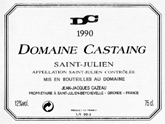
Classification: Cru Bourgeois
Owner: Jean-Jacques Cazeau
Address: 54, grand rue, 33250 St.-Julien-Beychevelle
Telephone: 05 56 59 25 60; Telefax:—Not available
Visits: By appointment Monday–Thursday
Contact: Jean-Jacques Cazeau
VINEYARDS
Surface area: 3 acres
Grape varietals: 50% Cabernet Sauvignon, 40% Merlot, 10% Cabernet Franc
Average age of vines: 50 years
Density of plantation: 10,000 vines per hectare
Average yields: 58 hectoliters per hectare
Elevage: Twenty-day fermentation and maceration. Twenty months aging in barrels that are renewed by a third at each vintage. Fining, no filtration.
WINES PRODUCED
Domaine Castaing: 9,000 bottles
No second wine is produced.
Plateau of maturity: Within 3–10 years of the vintage
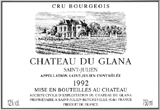
Classification: Cru Bourgeois Exceptionnel
Owner: GFA Vignobles Meffre
Address: 5, Le Glana, 33250 St.-Julien-Beychevelle
Mailing Address: c/o Vignobles Meffre, Les Applanats, 84190 Beaumes-de-Venise
Telephone: 05 56 59 06 47; Telefax: 05 56 59 06 47
E-mail: ludovicmeffre@yahoo.fr
Visits: By appointment Monday to Friday, 8 A.M.–noon and 2–6 P.M.
Contact: Ludovic Meffre
VINEYARDS
Surface area: 106.2 acres
Grape varietals: 65% Cabernet Sauvignon, 30% Merlot, 5% Cabernet Franc
Average age of vines: 20 years
Density of plantation: 6,666 vines per hectare
Average yields: 250,000 hectoliters per hectare
Elevage: Cold maceration. Three-week fermentation and maceration in temperature-controlled vats. Twelve months aging in barrels with 25% new oak. Fining and filtration.
WINES PRODUCED
Château du Glana: 150,000 bottles
Pavillon du Glana or Château Sirène: 100,000 bottles
Plateau of maturity: Within 2–8 years of the vintage
GENERAL APPRECIATION
This St.-Julien merits its Cru Bourgeois status. Usually reliable, Du Glana does represent an interesting quality/price ratio.
It has been said that Du Glana produces a blatantly commercial wine—soft, overtly fruity, and too easy to drink. Yet the prices are reasonable and the wine is ripe, cleanly made, and ideal for newcomers to Bordeaux. Some vintages tend to be jammy—2000, 1996, 1990, 1989, 1985, and 1982, for example—but in tastings people always seem to enjoy this plump St.-Julien. It must be drunk within its first decade of life, preferably before it turns eight years old.

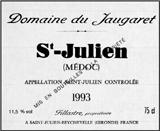
Classification: None
Owner: Fillastre family
Address: 33250 St.-Julien-Beychevelle
Telephone: 05 56 59 09 71
Visits: By appointment only
Contact: Jean-François Fillastre
VINEYARDS
Surface area: 3.3 acres
Grape varietals: 75% Cabernet Sauvignon; 20% Merlot; 5% Malbec, Petit Verdot, and Cabernet Franc
Average age of vines: 50+ years
Density of plantation: 10,000 vines per hectare
Average yields: 40 hectoliters per hectare
Elevage: Ten-day fermentation and 20-day maceration. Thirty to thirty-six months aging in barrels (no new oak). Fining, no filtration.
WINES PRODUCED
Domaine du Jaugaret: 5,000–6,000 bottles
No second wine is produced.
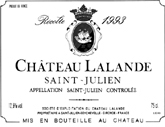
Classification: None
Owner: Jean-Paul Meffre
Address: 2, Grand Rue, 33250 St.-Julien-Beychevelle
Mailing Address: c/o Vignobles Meffre, Les Applanats, 84190 Beaumes-de-Venise
Telephone: 05 56 59 06 47; Telefax: 05 56 59 06 47
Visits: By appointment Monday to Friday, 8 A.M.–noon and 2–6 P.M.
Contact: Jean-Paul Meffre
VINEYARDS
Surface area: 79 acres
Grape varietals: 55% Cabernet Sauvignon, 40% Merlot, 5% Cabernet Franc
Average age of vines: 22 years
Density of plantation: 6,666 vines per hectare
Average yields: 58 hectoliters per hectare
Elevage: Cold maceration. Three-week fermentation and maceration. Twelve months aging in barrels with 25% new oak for 80% of the yield. Fining and filtration.
Château Lalande: 150,00 bottles
Château Marquis de Lalande: 30,000 bottles
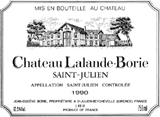
Classification: Cru Bourgeois
Owner: Borie family
Address: 33250 St.-Julien-Beychevelle
Telephone: 05 56 73 16 73; Telefax: 05 56 59 27 37
No visits
VINEYARDS
Surface area: 44.5 acres
Grape varietals: 65% Cabernet Sauvignon, 25% Merlot, 10% Cabernet Franc
Average age of vines: 25 years
Density of plantation: 10,000 vines per hectare
Average yields: 45 hectoliters per hectare
Elevage: Fifteen to eighteen-day fermentation in stainless-steel vats. Fourteen to sixteen months aging in barrels with 25–35% new oak. Fining, light filtration upon bottling.
WINES PRODUCED
Château Lalande-Borie: 90,000 bottles
No second wine is produced.
Plateau of maturity: Within 5–10 years of the vintage
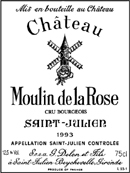
Classification: Cru Bourgeois in 1932
Owner: GFA des Domaines Guy Delon
Address: 33250 St.-Julien-Beychevelle
Telephone: 05 56 59 08 45; Telefax: 05 56 59 73 94
Visits: By appointment only
Contact: Guy Delon
VINEYARDS
Surface area: 11.9 acres
Grape varietals: 62% Cabernet Sauvignon, 28% Merlot, 5% Cabernet Franc, 5% Petit Verdot
Average age of vines: 30 years
Density of plantation: 8,500 vines per hectare
Average yields: 50 hectoliters per hectare
Elevage: Three-week fermentation and maceration in temperature-controlled stainless-steel tanks with frequent pumpings-over. Twenty months aging in barrels with 33% new oak. Seven rackings. Fining with egg whites. No filtration.
WINES PRODUCED
Château Moulin de la Rose: 30,000 bottles
No second wine is produced.
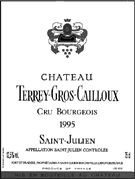
Classification: Cru Bourgeois
Owner: SCEA du Château Terrey-Gros-Cailloux
Address: 33250 St.-Julien-Beychevelle
Telephone: 05 56 59 06 27; Telefax: 05 56 59 29 32
Visits: Monday to Thursday, 9 A.M.–noon and 2–7 P.M.; Fridays, 9 A.M.–noon
Contact: Henri Pradère
VINEYARDS
Surface area: 34.5 acres
Grape varietals: 70% Cabernet Sauvignon, 25% Merlot, 5% Petit Verdot
Average age of vines: 35 years
Density of plantation: 10,000 vines per hectare
Average yields: 55 hectoliters per hectare
Elevage: Three-week fermentation in stainless-steel temperature-controlled vats. Twenty months aging in oak barrels that are renewed by 25% each year. Fining, no filtration.
WINES PRODUCED
Château Terrey-Gros-Cailloux: 100,000 bottles
No second wine is produced.
Plateau of maturity: Within 5–8 years of the vintage
The cellars of this well-run Cru Bourgeois are located just off the famous D2 in the direction of Gruaud Larose and Talbot. They house not only Terrey-Gros-Cailloux, but also the wine of Hortevie. Terrey-Gros-Cailloux tends to be a richly fruity, round, occasionally full-bodied wine that offers delicious drinking if consumed within the first 7–8 years. It is not long-lived, but the decision by the proprietors in the late 1980s to begin to use some new oak casks to give the wine more definition and structure should prove beneficial to the wine’s longevity.
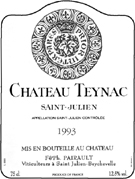
Classification: None
Owner: Fabienne et Philille Pairault
Address: Grand Rue, Beychevelle, 33250 St.-Julien-Beychevelle
Telephone: 05 56 59 12 91; Telefax: 05 56 59 46 12
E-mail: philetfab3@wanadoo.fr
Visits: By appointment only
Contact: Patrick Bussier
Telephone: 05 56 59 93 04; Telefax: 05 56 59 46 12
VINEYARDS
Surface area: 30.1 acres
Grape varietals: 78% Cabernet Sauvignon, 20% Merlot, 2% Petit Verdot
Average age of vines: 45 years
Density of plantation: 7,500 vines per hectare
Average yields: 50 hectoliters per hectare
Elevage: Three-week fermentation and maceration in temperature-controlled stainless-steel vats. Fourteen months aging in barrels with 40% new oak. Fining and filtration.
WINES PRODUCED
Château Teynac: 53,000 bottles
Château Les Ormes: 10,000 bottles
Margaux is certainly the largest and most sprawling of all the Médoc’s principal wine-producing communes. The 3,350 acres under vine exceed those of St.-Estèphe. A first-time tourist to Margaux immediately realizes just how spread out the châteaux of Margaux are. Only a few sit directly on Bordeaux’s Route du Vin (D2), and these are Dauzac, Prieuré-Lichine, Palmer, and Malescot St.-Exupéry. Château Margaux is just off the main road in the town of Margaux, but the other major châteaux are sprinkled throughout the five principal communes of this appellation: Arsac, Labarde, Cantenac, Margaux, and Soussans.